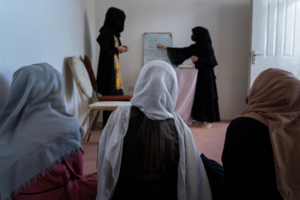Where Learning Is Against the Law: A Secret School for Afghan Girls
On a quiet residential street, teenage girls with school bags swiftly entered a large green gate. They were dressed in traditional garb, their faces covered, and many were holding copies of the Quran, Islam’s holy book. It was for their own protection.
The house is a secret school for Afghan girls who are barred by the Taliban from getting an education. If agents raid the house, the girls will pull out their Qurans and pretend they are in a madrassa, or Islamic school, which the country’s new rulers still allow girls to attend.
“The Taliban are floating around in this area,” said Marina, 16, a 10th-grader. “So, I always carry a Quran in the open. My other books are hidden in my bag.”
More than a year after seizing power in Afghanistan, the Taliban still refuses to allow girls to attend secondary school, from grades seven to 12. The ban, as well as other hard-line edicts restricting women’s lives, have triggered global outrage and widespread protests by Afghan women.
But a more subtle form of defiance is also happening. Underground schools for girls have formed in the capital and other Afghan cities, hidden away in houses and apartments, despite the immense threat to students and teachers. For the girls and their families, it is worth the risk.
“It doesn’t matter if the Taliban becomes aware of this school,” said Angila, also 16 and in the 10th grade. “Education is my basic right. No one can take that away.”
Washington Post journalists made several visits last month to a secret school in Kabul where 25 girls were taught in various subjects for roughly two hours a day. Classes were kept short to lessen the chances of discovery by the Taliban. The girls and their teacher spoke on the condition that they be identified only by their first names, fearing retaliation from the authorities.
The Taliban has said repeatedly that secondary schools for girls will reopen when there is an appropriate “Islamic environment.” But the group has provided no criteria for what constitutes such an environment.
When the Taliban first seized power in 1996, it closed schools for all girls —then too, underground schools were formed to fill the void —banned women from working and forced them to wear head-to-toe coverings known as burqas whenever they ventured outside the home.
The group has been less draconian this time around, and the issue of education has revealed divisions among the Taliban’s leaders and religious scholars. In some areas, local Taliban officials have allowed girls above sixth grade to attend school, bowing to pressure from community leaders.
Last month, the Taliban’s deputy foreign minister, Sher Mohammad Abbas Stanikzai, made a rare public appeal urging that all secondary schools for girls be reopened, adding that “the delay is increasing the gap between [the government] and the nation.”
“Education is obligatory on both men and women, without any discrimination,” Stanikzai said in a televised speech. “No one can offer a justification based on sharia [Islamic law] for opposing this.”
But the hard-line conservative leaders who form the backbone of the movement remain opposed. And the Taliban has issued other restrictions, including mandating that women wear a face veil. Last month, a conservative cleric loyal to the hard-liners was appointed as the education minister.
